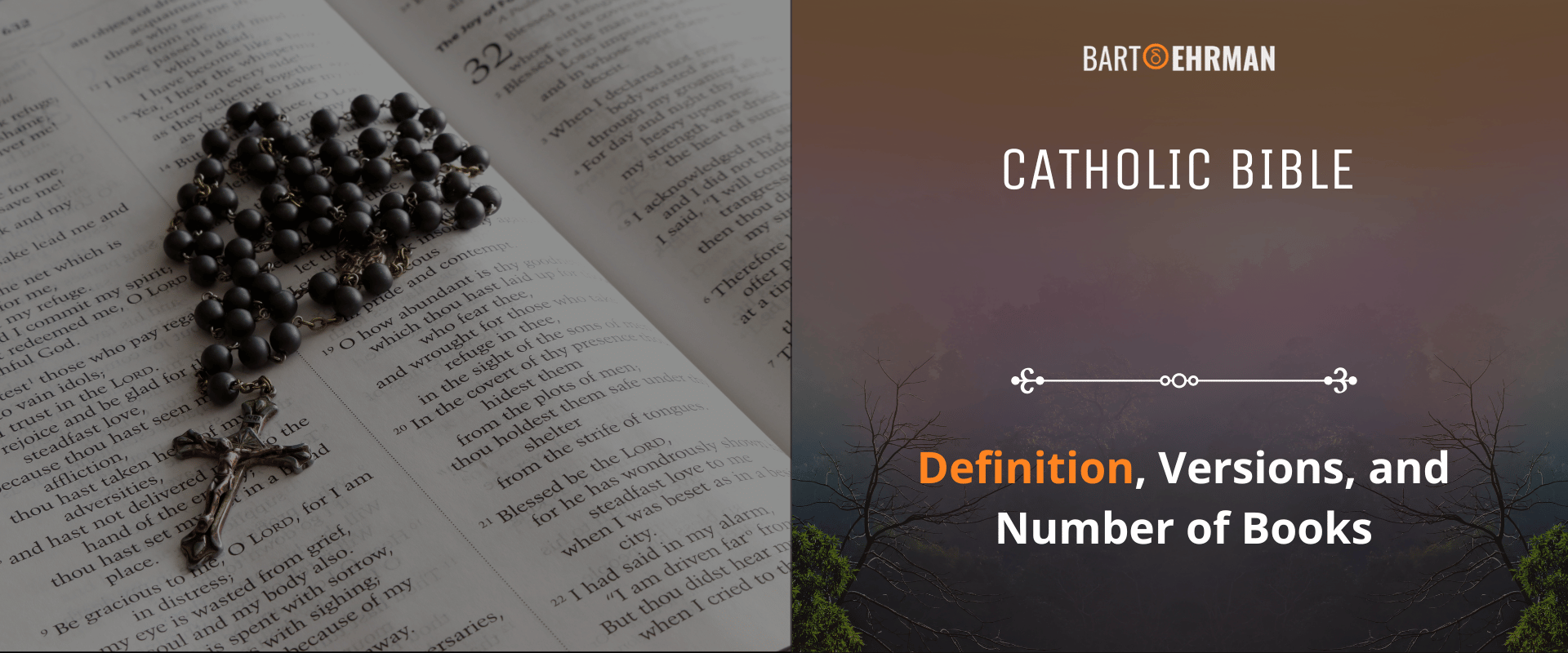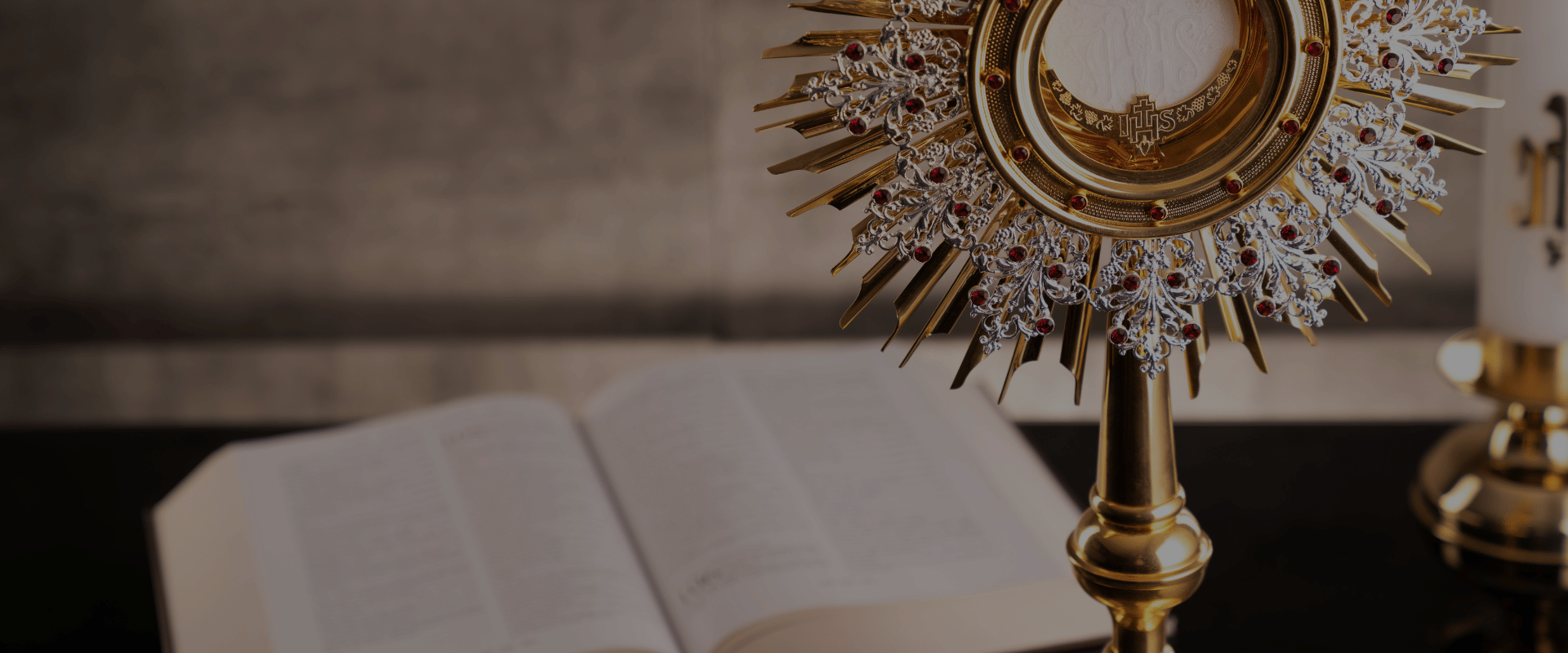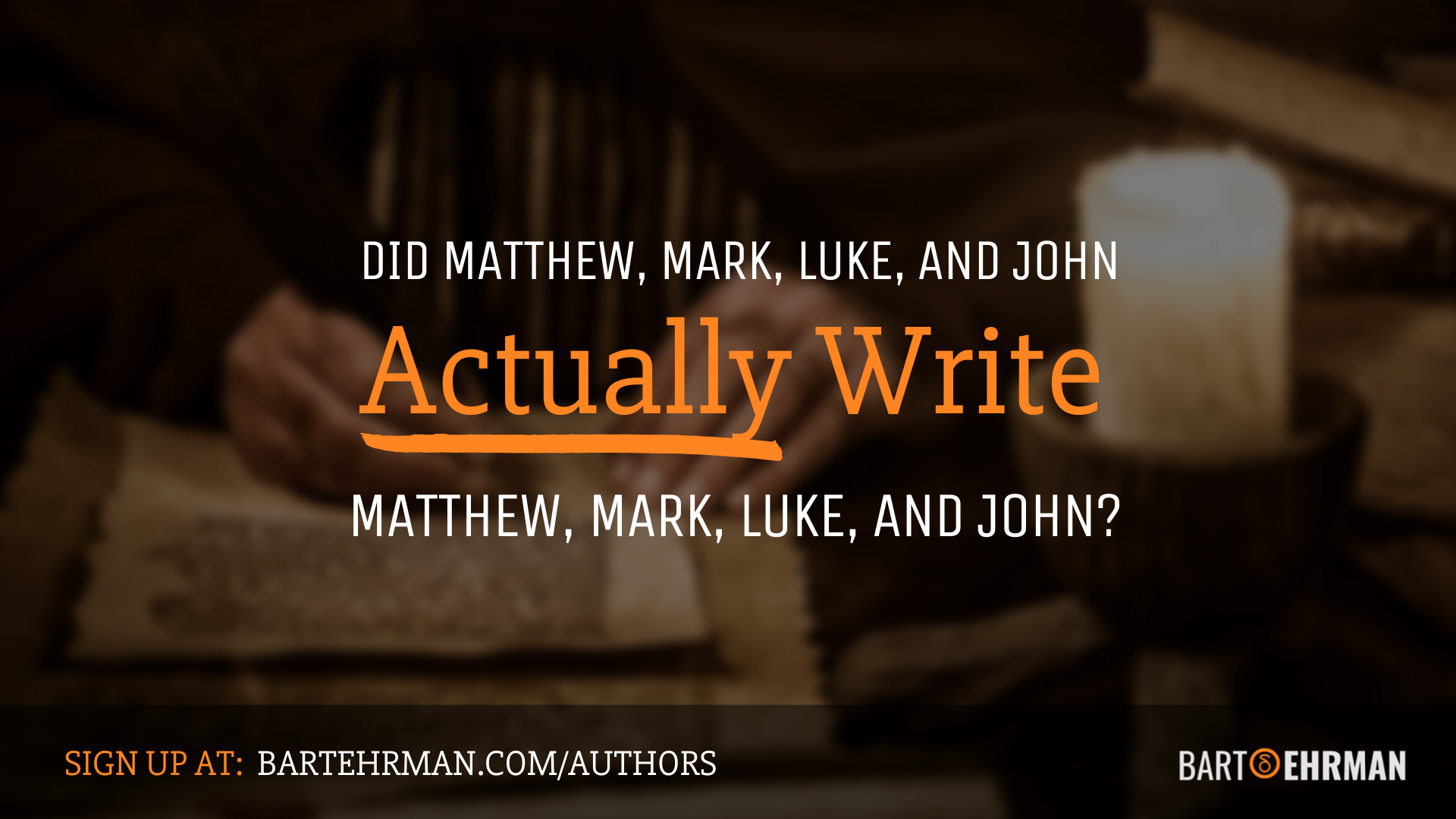Catholic Bible - Definition, Versions, and Number of Books

Written by Marko Marina, Ph.D.
Author | Historian | BE Contributor
Verified! See our guidelines
Verified! See our editorial guidelines
Date written: March 1st, 2024
Disclaimer: The views and opinions expressed in this article belong to the author and do not necessarily match my own. - Dr. Bart D. Ehrman
Growing up in Croatia, a country woven deeply with the threads of Catholic tradition, my earliest memories of Scripture were intertwined with the pages of the Catholic Bible. This wasn’t just a book; it was a cornerstone of faith for many around me, its stories and teachings echoing through the very culture of my homeland.
It wasn't until later in life that I discovered the existence of the Christian (Protestant) Bible, sparking a curiosity that led me to explore why the Catholic Bible has more books than its Protestant counterpart.
This journey into the heart of biblical canon history not only broadened my understanding of Christian scriptures but also underscored the rich well of beliefs and traditions that shape our interpretations of the book that shaped our civilization in more ways than we can count.
In this article, we embark on a historical exploration of the Catholic Bible, delving into its composition, and the historical and theological nuances that distinguish it from the Protestant Bible.
Our objective isn’t to affirm or deny the beliefs inherent to these religious texts but to present an academic perspective on why the Catholic Bible includes additional books and how these have influenced both the tradition and the faith of its adherents.
By examining the processes of canonization, the councils that played pivotal roles in shaping the Catholic canon, and the evolution of its translations, we aim to shed light on the complexities of Christian history.

Roman Catholicism: A Religion Behind the Book
The diversity that shaped the earliest years and decades of the Christian movement hasn’t only persisted but flourished into the present day. Today, Christianity encompasses a myriad of forms and expressions, uniting over 2 billion followers under its broad spiritual canopy.
Among these varied streams, Roman Catholicism stands out as a distinct and influential tradition. This branch of Christianity, with its deep historical roots and rich theological tapestry, continues to play a pivotal role in the religious landscape worldwide.
Roman Catholicism, as a major denomination within Christianity, is characterized by its unique structure, traditions, and theological beliefs. Central to the Catholic faith is the authority of the Pope, regarded as the spiritual and historical successor to Saint Peter, entrusted with the leadership of the Catholic Church.
This hierarchical structure is supported by the Magisterium, the church's authoritative teaching office, which guides Catholics in matters of faith and morals based on Sacred Scripture and Sacred Tradition.
Key practices that distinguish Roman Catholicism include the celebration of seven sacraments—Baptism, Confirmation, Eucharist, Penance, Anointing of the Sick, Holy Orders, and Matrimony—each considered a means of grace.
The veneration of saints, particularly the Virgin Mary, as models of faith and intercessors for believers, also marks Catholic practice. Moreover, the Catholic Bible includes several books not found in the Protestant (Christian) Bible. We’ll soon see the historical background of this interesting difference.
While this article focuses on the Catholic Bible and its distinct features within the broader Christian tradition, readers interested in a deeper comparison of Roman Catholicism and Protestant Christianity are encouraged to refer to our previous article.
Catholic Bible: A Short Overview
The Catholic Bible stands as a monumental compilation of sacred texts, foundational to the faith and practice of millions around the globe. Distinctive in its composition, the Catholic Bible encompasses 73 books of the Bible: 46 books of the Old Testament, and 27 books of the New Testament.
This assemblage not only comprises the texts found in Protestant Bibles but also integrates additional Old Testament books known as the Deuterocanonical books. They aren’t included in the canonical list recognized by most Protestant denominations.
The Catholic Bible, therefore, offers a broader lens through which believers detect the continuity and development of God's revelation to humanity. Its composition underscores the diversity of religious texts that have shaped Christian thought and tradition over millennia.
By engaging with the 73 books of the Catholic Bible, readers encounter a comprehensive narrative that spans from the creation of the world to the early Christian community, enriched by wisdom, poetry, and historical accounts unique to the Christian tradition.
What Are the 7 Extra Books in the Catholic Bible?
How many books are in the Catholic Bible? As mentioned, the Catholic Bible distinguishes itself by including seven extra books not found in the mainstream 66-book Protestant Bible. These books are:
#1 Tobit
This book tells the story of two Israelite people, a blind man named Tobit living in Nineveh and a woman named Sarah, living in a city called Ecbatana. Tobit sends his son Tobias to retrieve some money he’d left in another city. An angel named Raphael guides Tobias to Ecbatana, where he meets Sarah. Raphael saves Sarah from a demon and Tobias marries Sarah. They return to Tobit who has been miraculously cured of his blindness.
#2 Judith
Judith, a Jewish widow, attracts and seduces an Assyrian general besieging her city. Having ingratiated herself with him, she waits until he is drunk and then decapitates him, saving the capital Jerusalem from destruction.
#3 1 Maccabees
This is the story of the Maccabean Revolt against the Seleucid Empire, whose King Antiochus IV Epiphanes issued decrees demanding that Jews forget Jewish culture and accept Greek language and culture.
#4 2 Maccabees
More stories of the Maccabean Revolt against King Antiochus IV Epiphanes. It ends with the defeat of the Seleucid Empire by Judas Maccabeus, the leader of the Maccabees.
#5 Wisdom (of Solomon)
This book centers on the importance of Wisdom as related to humans and God. It may have influenced the famous prologue of the Gospel of John, with wisdom replaced by the “Word.”
#6 Sirach (Ecclesiasticus)
This is the only book of the Apocrypha for whom we know the author, Jesus son of Sirach. We know this because his grandson, Ben Sira of Jerusalem, translated the original Hebrew document into Greek and wrote a prologue. The book is entirely based on ethical teachings.
#7 Baruch, including the Letter of Jeremiah.
Baruch consists of contemplations by a Jewish writer about past Jewish exiles from Babylon. It includes theology and thoughts on wisdom.

Why the Catholic Bible Has More Books?
This difference stems from the inclusion of these seven Deuterocanonical books in the Catholic canon—a decision rooted in the early Christian era and the development of what is often referred to by Protestant Christians and Jews as the “Old Testament Apocrypha.”
The term “Old Testament Apocrypha,” originating from the Greek word for "hidden" or "secret," traditionally refers to writings not found in the Jewish or Protestant biblical canons.
Among these, the Deuterocanonical books have a distinct status within the Catholic Bible, contrasting with the broader category of the Old Testament Apocrypha, which encompasses a wider range of texts.
The genesis of the Apocrypha can be traced to the Septuagint, a Greek translation of Jewish Scriptures, which served as the sacred text for Greek-speaking Christians and Jews. This translation included books written both in Hebrew, like Genesis and Exodus, and in Greek, such as 1 and 2 Maccabees.
The Septuagint was characterized by its lack of a standardized composition, at times including additional texts like 3 and 4 Maccabees. The delineation of the Hebrew Bible around 200 C.E. by Jewish scholars, which omitted Greek-origin texts, marked a pivotal moment, introducing a division between the Jewish and early Christian scriptural traditions.
This division was underscored during the Protestant Reformation when figures like Luther and Calvin advocated for an Old Testament confined to Hebrew-origin texts, excluding the Deuterocanonical books from the Protestant canon. However, they didn’t deem these excluded books as heretical, recognizing their value for spiritual edification, albeit not as sources of doctrine.
Did You Know?
The Dark Side of the Medieval Church Councils. While medieval Church councils were pivotal in shaping the doctrines and practices of Christianity, they also had a darker, more controversial role. Take, for instance, the Council of Constance (1414-1418), renowned not just for its theological deliberations but also for its condemnation of Jan Hus and Jerome of Prague as heretics. Their crime? Challenging the Church's authority with reformative teachings. The verdict was grim: both were handed over to secular authorities and burned at the stake, Hus in 1415 and Jerome in 1416.
It’s essential to distinguish between the Deuterocanonical books and the broader category of Old Testament Apocrypha. The latter includes various texts recognized differently across Christian denominations. For instance, the Eastern Orthodox Church considers books like 1 Esdras canonical, which the Catholic Church doesn’t.
Books | Protestant Christian | Roman Catholic | Eastern Orthodox |
|---|---|---|---|
66 Books of the Protestant Bible | Included | Included | Included |
Deuterocanonical books (Tobit, Judith, etc.) | Not Included | Included | Included |
Prayer of Manasseh | Not Included | Not Included | Included |
Odes | Not Included | Not Included | Included |
1 & 2 Esdras | Not Included | Not Included | Included |
1 & 2 Maccabees | Not Included | Included | Included |
3 & 4 Maccabees | Not Included | Not Included | Included |
On the other hand, the Deuterocanonical books, in this aspect, refer to those seven texts within the Old Testament that are canonized within the Catholic tradition. This distinction emphasizes the Catholic Bible's expansive scriptural understanding, embracing a diversity of texts that reflects the early Church's usage.
This difference in the canon highlights a fundamental aspect of the “Catholic vs. Christian Bible” debate, reflecting not only theological but also historical and cultural divergences within Christianity. As such, the Catholic Bible, with its 73 books, offers a rich and varied scriptural landscape that has shaped the Catholic religion for centuries.
Having explored the distinctive composition of the Catholic Bible and the historical context of the Deuterocanonical books, we now transition to examining the origins and formation of the Catholic Bible as we know it today.
This journey takes us through key Church councils that played pivotal roles in shaping the Catholic canon, illuminating the processes and deliberations that defined this sacred collection.
The Formation of the Catholic Bible: Canons and Councils
The formation of the Catholic Bible is deeply intertwined with the history of the Church's councils, a practice rooted in both the Jewish and Greco-Roman worlds of antiquity.
In the Jewish tradition, the Sanhedrin, an assembly or court, operated in each town and more notably in Jerusalem, serving not merely as a deliberative body but akin to a Supreme Court for issues Jewish law at the local level could not resolve.
This model of collective decision-making, alongside the early Christian precedent set by the Jerusalem Council in the mid-1st century, where leaders including Paul debated the inclusion of pagan converts and their adherence to Jewish law, highlighted the importance of communal debate and resolution in religious matters.
Similarly, the Greco-Roman tradition of the Boule and the Senate, where leading citizens convened to discuss vital issues, provided a civic model for assembly and decision-making.
These historical precedents informed the Christian Church's adoption of councils as a means to deliberate and decide on critical theological and organizational issues, including the canon of scripture.
Within this historical framework, several key councils stand out for their significant contributions to the formation of the Catholic Bible:
#1 Council of Rome (382):
This council, under the guidance of Pope Damasus I, played a foundational role in the development of the Catholic canon.
It was here that a formal list of Christian scriptures was proposed, aligning closely with the Catholic Bible as it is recognized today. This council's decisions were pivotal in establishing the core texts that would be considered authoritative within the Catholic tradition.
#2 Council of Hippo (392):
The Council of Hippo marked another critical step in the canonization process, affirming the list of books proposed by the Council of Rome.
This affirmation included the acceptance of the Deuterocanonical books as part of the Old Testament, thereby solidifying their place within the Catholic Bible. The council's endorsement further emphasized the Church's role in defining the contents of sacred scripture.
#3 Council of Carthage (397 and 419):
The Councils of Carthage reinforced and expanded upon the decisions made at Rome and Hippo, providing additional ecclesiastical weight to the canonization of the Catholic Bible books. These councils were instrumental in ratifying the list of canonical texts, ensuring a degree of consistency and universality in the scriptures that were to be read and used in the liturgical life of the Church.
However, it’s important to note that these councils weren’t ecumenical. These were local or regional synods attended by bishops of the Western Roman Empire, primarily representing the Latin (Rome-oriented) Church.
They played crucial roles in the early development of the Christian biblical canon, particularly the canon recognized by the Roman Catholic Church, but they didn’t have the same broad, Church-wide representation as the ecumenical councils such as the Council of Nicaea.
Nevertheless, the books of the Catholic Bible that emerged after these councils, as John Bergsma and Brant Pitre explain, “became the standard for churches in communion with Rome through the rest of antiquity and the Middle Ages.” That, however, changed with the rise of the Protestant Reformation in the 16th century.
#4 Council of Trent (1545 - 1563):
In response to the Reformation and the challenges it posed to Catholic doctrine and practice, the Council of Trent definitively confirmed the canon established by earlier councils, including the Deuterocanonical books.
It’s particularly noteworthy that the council's decision regarding the canon of Scripture was embedded within its decree on divine revelation. This approach underlines a profound theological standpoint concerning the nature of revelation and its relationship with Scripture.
As Joseph Kelly elucidates: "The Protestant reformers equated revelation with Scripture, while the bishops asserted a wider understanding and one that allowed for revelation to continue in the church. In this same decree, they then listed the books of the Bible, affirming the Catholic canon, which most Protestants repudiated, disagreeing with Catholics on the number of books in the Old Testament."
The Council of Trent, thus, not only reaffirmed the specific books that constitute the Catholic Bible but also articulated a vision of revelation that extends beyond the written word, encompassing the living tradition of the Church Its decrees on the canon represented a reassertion of Catholic tradition and an explicit affirmation of the Catholic Bible's composition.
Catholic Bible: Important Versions
As an infamous character in Dan Brown's bestseller "The Da Vinci Code" claims: "The Bible didn't arrive by fax from heaven." This quip, though fictional, underscores a profound truth about the Bible's origins. It was indeed composed over many centuries by various authors who lived in vastly different historical and cultural contexts.
Furthermore, the Bible has never had just one "original" version. This narrative is equally pertinent to the Catholic Bible, a compilation of sacred texts that has undergone significant transformations through translations and revisions to address the evolving needs of the faithful and the Church's doctrinal clarity.
The journey of the Catholic Bible's translations begins with the Vulgate, a principal Latin version translated by St. Jerome in the late 4th century. Commissioned by Pope Damasus I, the Vulgate sought to unify the scriptural texts for the Western Church, offering a singular, authoritative version for liturgy and study.
Its significance cannot be overstated; for centuries, it was the Bible for countless Catholics, shaping theology, liturgy, and education throughout Christendom.
In the wake of the Reformation and the advent of the printing press, the Catholic Church found it necessary to provide the scriptures in the vernacular languages of its followers. The Douay-Rheims Bible, completed in the late 16th century, served this purpose for English-speaking Catholics.
Translated from the Latin Vulgate, it was the standard Bible for English Catholics for many years, known for its rigorous adherence to the Vulgate's text and its influence on subsequent English translations of the Bible.
The 20th and 21st centuries witnessed the emergence of modern translations aimed at improving accessibility, readability, and scriptural scholarship.
Among these, The New American Bible (NAB), first published in 1970, is notable for its use in the liturgy in the United States. Similarly, The Jerusalem Bible, introduced in 1966, gained recognition for its literary quality and comprehensive annotations.
The New Revised Standard Version, Catholic Edition (NRSV-CE), is another important translation, esteemed for its scholarly accuracy and inclusive language, reflecting the latest in biblical scholarship and manuscript discovery.
For readers interested in a deeper exploration of the various versions of the Bible, we recommend the detailed analysis provided by my colleague Joshua Schachterle, in his insightful article. His work complements this overview by offering a broader perspective on the Bible's textual evolution and the distinct approaches taken by different Christian traditions in translating the scriptures.
Summing up Conclusion
In this exploration of the Catholic Bible, we have navigated through its historical development, canon formation, and the intricate distinctions that set it apart from the Christian (Protestant) Bible.
A critical aspect of our discussion has been the role of various Church councils, from Rome to Trent, in shaping the Catholic canon.
These councils, reflective of the Church's response to theological and doctrinal challenges over centuries, underscore the complex process of canon formation—a process influenced by a myriad of factors, including theological debates, ecclesiastical authority, and the dynamics of Christian unity and division.
The distinction between the Deuterocanonical books and the broader category of the Old Testament Apocrypha was clarified, highlighting the nuanced perspectives within Christian traditions regarding the scope of sacred scripture. This delineation not only addresses the "What is a Catholic Bible" inquiry but also frames the discussion within the broader context of scriptural interpretation and tradition.
In conclusion, this article has sought to provide a balanced and scholarly overview of the Catholic Bible, mindful of the historical, theological, and cultural dimensions that contribute to its unique place within Christianity.
By examining the formation, content, and significance of the Catholic canon, we aim to contribute to a deeper understanding of the Catholic Bible's role in the broader tapestry of Christian scripture and tradition.
For those intrigued by the scholarly exploration of sacred texts, delve deeper with Dr. Bart D. Ehrman's course, "In the Beginning: History, Legend, and Myth in Genesis." This course offers a profound examination of the Book of Genesis, expertly distinguishing between historical reality and mythological narrative. Embark on this enlightening journey to enhance your understanding of one of the most pivotal books in the Bible.
FREE COURSE!
WHY I AM NOT A CHRISTIAN
Raw, honest, and enlightening. Bart's story of why he deconverted from the Christian faith.
Over 6,000 enrolled!

